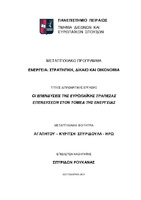Οι επενδύσεις της Ευρωπαϊκής Τράπεζας Επενδύσεων στον τομέα της ενέργειας

Master Thesis
Συγγραφέας
Αγαπητού - Κυρίτση, Σπυριδούλα - Ηρώ
Ημερομηνία
2021-09Επιβλέπων
Ρουκανάς, ΣπυρίδωνΠροβολή/
Λέξεις κλειδιά
Ενέργεια ; Ευρωπαϊκή Τράπεζα Επενδύσεων ; Ενεργειακές επενδύσεις ; Συμφωνία Παρισίων ; Κλιματική αλλαγή ; Κριτήρια επιλεξιμότηταςΠερίληψη
Η Ευρωπαϊκή Τράπεζα Επενδύσεων (ΕΤΕπ) ιδρύθηκε το 1957, με την ίδρυση της Ευρωπαϊκή Οικονομική Κοινότητα (ΕΟΚ). Από την αρχή της ίδρυσής της, η ΕΤΕπ είχε ως στόχο την ισόρροπη και απρόσκοπτη ανάπτυξη της εσωτερικής αγοράς προς το συμφέρον της Ένωσης μέσω της παροχής μεγάλων δανείων και εγγυήσεων για τη χρηματοδότηση έργων σε όλους τους τομείς της οικονομίας, σε μία μη κερδοσκοπική βάση.
Μελετώντας την δράση της ΕΤΕπ μέσα από τη φύση των έργων που χρηματοδότησε από το 1958 έως το 2004, παρατηρείται ότι δανειοδοτεί τα έργα με διαφορετικά κριτήρια, ανάλογα με την εποχή και τις ανάγκες της Ένωσης. Την πρώτη περίοδο, μεταξύ των ετών 1958 και 1972, η ΕΤΕπ λειτούργησε προς όφελος της ανάπτυξης των μη αναπτυγμένων περιοχών της ΕΟΚ. Την επόμενη περίοδο, από το 1973 έως τα μέσα της δεκαετίας ’80, η δανειοδότηση της ΕΤΕπ ήταν ευθυγραμμισμένη με την ευρωπαϊκή πολιτική για ενεργειακή ανεξαρτησία ενώ παράλληλα λειτουργούσε ως παράγοντας προσέλκυσης για νέα κράτη μέλη. Την τελευταία περίοδο, από τα μέσα της δεκαετίας του ’80 έως το 2004, λειτούργησε ως «δημιουργός της αγοράς», με την χρηματοδότηση της να λειτουργεί για την εδραίωση της Ενιαίας Αγοράς, στη λογική της ιδιωτικοποίησης, της απορρύθμισης και της απελευθέρωσης της αγοράς.
Μετά τη Συμφωνία των Παρισίων, η ΕΕ θα έχει έναν ηγετικό ρόλο στην αντιμετώπισης της κλιματικής αλλαγής. Η ΕΤΕπ, ως η τράπεζα της ΕΕ, καλείται να παίξει σημαντικό ρόλο στη χρηματοδότηση έργων για την επίτευξη των ευρωπαϊκών ενεργειακών στόχων τις επόμενες δεκαετίες. Οι επενδύσεις που θα απαιτηθούν για την επίτευξη των στόχων είναι σύνθετες και έχουν υψηλό αρχικό επενδυτικό κόστος.
Έτσι, από τον Νοέμβριο του 2019, εκδόθηκε από την ΕΤΕπ ο «Οδηγός Πολιτικής Δανειοδότησης για την Ενέργεια» ο οποίος καθορίζει τα κριτήρια επιλεξιμότητας των ενεργειακών επενδύσεων, ακολουθώντας στενά την ενεργειακή πολιτική της ΕΕ. Στον οδηγό αυτόν περιλαμβάνονται τέσσερις βασικοί άξονες: η βελτίωση της ενεργειακής απόδοσης, η απαλλαγή του ενεργειακού εφοδιασμού από τις ανθρακούχες εκπομπές, η ενίσχυση της καινοτομίας και των νέων τύπων ενεργειακών υποδομών, και τέλος η διασφάλιση της αναγκαίας υποδομής για τη λειτουργία των δικτύων ενέργειας.
Έτσι η ΕΤΕπ, μπαίνει σε μία νέα εποχή καθιστώντας την ίδια ως μία «ενεργειακή τράπεζα».


